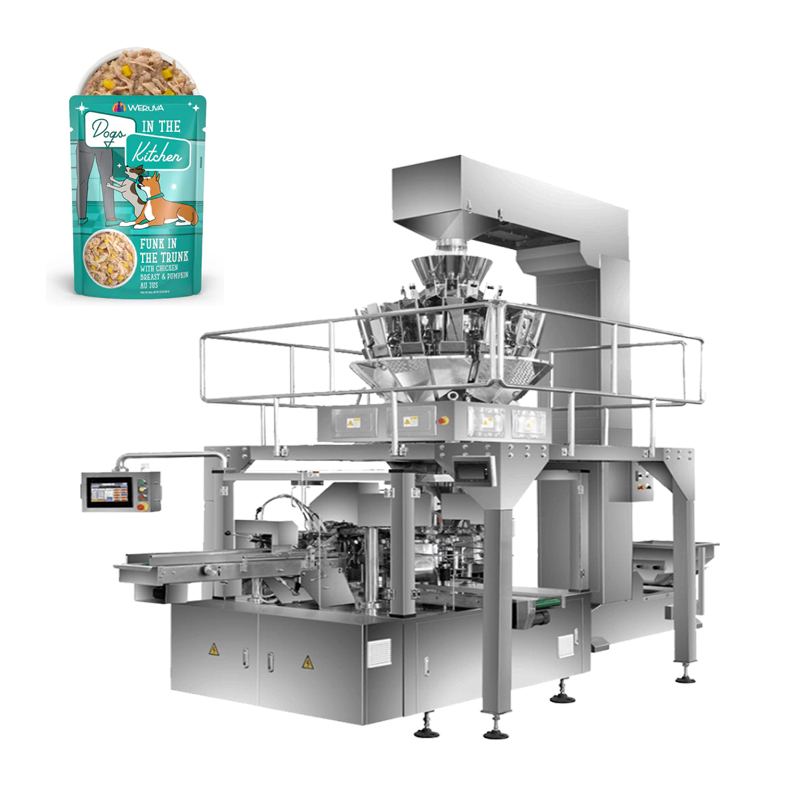Since 2012 - Smart Weigh is committed to helping clients increase productivity at a reduced cost. Contact us Now!
Since 2012 - Smart Weigh is committed to helping clients increase productivity at a reduced cost. Contact us Now!
The owners of pets are concerned with what they put into the bowl of their pets but they are also concerned with the packaging of the food. Wet pet food has special needs since it has to remain fresh, safe and appetizing. That’s where a wet pet food packaging machine comes in.
This guide walks you through packaging formats, machine types, the production process, and even troubleshooting tips so you can understand why these machines are so important. Read on to learn more.
Let's start by examining the primary types of packaging formats and the materials that make wet pet food safe, fresh and easy for pets to eat.
Wet pet food comes in many forms. The most common packaging formats are:
● Cans: High shelf life, strong and heavier to transport.
● Pouches: Easy to open, lightweight and popular with single-serve portions.
Each format has pros and cons. A wet pet food packing machine can handle more than one type depending on the setup.
The material used is just as important as the format.
● Multi-layer plastic films keep out air and moisture.
● Metal cans protect against light and heat.
The proper materials prolong shelf life, seal flavor and preserve food.

Now that we know the packaging formats, let’s see the different machines that make wet pet food packaging fast, safe and reliable.
This machine is designed to pack wet pet food into pouches with speed and accuracy. The multihead weigher ensures each pouch gets the exact portion of food, reducing waste and keeping consistency across every pack. It’s a good fit for companies that need efficiency and high output.
This type adds vacuum sealing to the process. After filling, the air is removed from the pouch before sealing. That helps preserve freshness, extend shelf life, and protect food quality during storage and transport. It's especially useful for wet pet food products that need longer stability.
This system combines multihead weighing accuracy with specialized can handling technology. After weighing, products flow directly into cans with consistent portion control that eliminates costly overfill. That helps reduce product waste, improve profit margins, and maintain quality standards across every production run. It's especially useful for high-value products like nuts and confectionery that need exact portion control.

Now we know about the machines, so we are going to discuss how wet pet food is packed step-by-step.
The process usually looks like this:
1. Food enters the system from a hopper.
2. A multihead weigher or filler measures the portion.
3. Packs are formed or placed (pouch or can).
4. Food is deposited into the package.
5. A sealing machine closes the pack.
6. Labels are added before distribution.
Safety is key. Wet food must stay free from bacteria and contamination. Machines are often built with stainless steel and hygienic design to allow easy cleaning. Some systems also support CIP (clean-in-place) to sanitize without disassembly.

Wet pet food does not have the same packaging as dry food and therefore, we will compare the main differences in terms of process and equipment.
● Wet food needs airtight seals, while dry food needs moisture barriers.
● Cans or retort pouches are common in wet food packaging whereas bags or boxes are used in dry food packaging.
● Wet food requires more advanced sealing to prevent leaks.
A wet pet food packaging machine often includes can seamers, or pouch fillers. Dry food lines rely more on bulk fillers and bagging systems. Both types benefit from multihead weighers for accuracy.
The best machines still have troubles, so we will take a look at common issues and what to do to fix them.
Weak seals can cause leaks. Solutions include:
● Checking sealing temperature.
● Replacing worn sealing jaws.
● Ensuring packaging film is high quality.
Portion errors waste money and frustrate customers. Fixes include recalibrating the filling machine or adjusting the multihead weigher.
Like any machine, these systems need care:
● Regular cleaning to prevent buildup.
● Timely lubrication of moving parts.
● Following the manufacturer’s maintenance schedule.
A wet pet food packaging machine contributes immensely to ensuring the products are safe, fresh and appealing. Cans, trays, pouches, these machines can help businesses provide quality with speed and efficiency. Whether it’s accurate filling, strong sealing, or integrated systems with multihead weighers, the benefits are clear.
Want to take your pet food production to the next level? At Smart Weigh Pack, we design advanced wet pet food packing machines that keep your line running smoothly while saving time and money. Contact us today to explore solutions tailored to your business needs.
FAQs
Question 1. What packaging formats are most common for wet pet food?
Answer: The most used formats are cans and pouches since they can keep it fresh and convenient.
Question 2. What is the difference between wet and dry pet food packaging?
Answer: Airtight seals and moisture-resistant materials are necessary in packaging wet food, whereas dry food packaging pays more attention to moisture control.
Question 3. How can I maintain a wet pet food packaging machine?
Answer: Wash regularly, check seals and follow the manufacturer's maintenance manual. Most of the machines are made with stainless steel to facilitate easy cleaning.
Question 4. What are common issues faced during the packaging process?
Answer: Typical problems include weak seals, filling errors, or lack of maintenance. Regular checks and proper machine care prevent most issues.
CONTACT US
Building B, Kunxin Industrial Park, No. 55, Dong Fu Road , Dongfeng Town, Zhongshan City, Guangdong Province, China ,528425
How We Do It Meet And Define Global
Related Packaging Machinery
Contact us, we can give you professional food packaging turnkey solutions

Copyright © Guangdong Smartweigh Packaging Machinery Co., Ltd. | All Rights Reserved